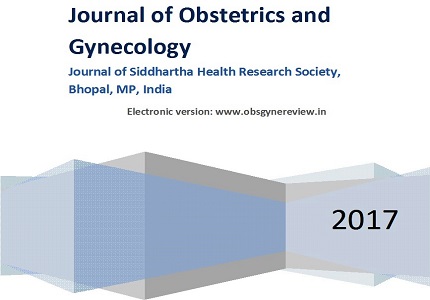Knowledge, attitude and practice towards exclusive breast feeding among lactating mothers in a South Indian Hospital
Abstract
Background: Exclusive breast feeding (EBF) isconsidered when the infant does not receive any additional food or nutriment other than breast milk. Aims and
Objectives: The object of the study was to assess knowledge, attitude and practice towards EBF among lactating mothers in a south Indian hospital.
Materials and Methods: This cross-sectional study was conducted among 300 mothers, attending outpatient department of a tertiary care hospital, Karpaga Vinayaga Institute of Medical Sciences over a period of one year. They were administereda structured questionnaire which sought such information as age, educational status, occupation, initiation of breast feeding, prelactealfeeding and knowledge and practice of exclusive breast feeding.
Results: Exclusive breast feeding was given for six months by 77.3% of study population. Their knowledge to start early breast feeding wasgood (57.7%). Formula milk was the most commonly used top milk (25.7%). Not enough breast milk (38%) and baby didn’t drink well (15.3%) were the main reasons for stopping breastfeeding.
Conclusion: Exclusive breastfeeding during approximately the first 6 months of life with continued breast feeding through at least the second half of infancy is associated with reduced risk of adverse outcomes in mother and infant.
Downloads
References
2. Committee on Health care for Underserved Women, American College of Ob/Gyn, Breast feeding: Maternal and Infant Aspect ACOG Committee Opinion, 361, February 2007.
3. Scanlon KS, Grummer, Strawn L, Chen J, et al. Racial and ethnic differences in breastfeeding initiation and duration, by State – National immunization survey. United States, 2004- 2008. MMWR 59: 327, 2010.
4. Ahluwalia IB, Morrow B, Hsia J, Grummer-Strawn LM. Who is breast-feeding? Recenttrends from the pregnancyrisk assessment and monitoringsystem.J Pediatr. 2003 May;142(5):486-91. [PubMed]
5. Newton ER. Breastmilk: the goldstandard. ClinObstet Gynecol. 2004 Sep;47(3):632-42. [PubMed]
6. Dewey KG. Growthcharacteristics of breast-fedcompared to formula-fedinfants. Biol Neonate. 1998;74(2):94-105. [PubMed]
7. Lucas A, Morely R, Cole TJ: Randomized trial of early diet in preterm babies and later intelligence quotient. BMJ 31: 1481, 1999. [PubMed]
8. Hanson LA. Human milk and hostdefence: immediate and long-term effects. Acta Paediatr Suppl. 1999 Aug;88(430):42-6.
9. Dettuwyler KA: A time to wean: the hominid blueprint for the natural age of weaning in modern human populations. In Stuart. MacAdanP,Dettwyler KA (eds): Breastfeeding: Biocultural Perspectives, New York, Aldine de Gruyter,1995.
10. Dewey KG, Nommsen-Rivers LA, HeinigMJ, Cohen RJ. Risk factors for suboptimalinfantbreastfeedingbehavior, delayedonset of lactation, and excessneonatalweight loss. Pediatrics. 2003 Sep;112(3 Pt 1):607-19.
11. Patel RR, Liebling RE, Murphy DJ. Effect of operativedelivery in the secondstage of labor on breastfeedingsuccess.Birth. 2003 Dec;30(4):255-60. [PubMed]
12. Egli GE, Egli NS, Newton M. The influence of the number of breast feedings on milkproduction. Pediatrics. 1961 Feb;27:314-7. [PubMed]
13. Howard C, Howard F, Lawrence R, Andresen E, DeBlieck E, Weitzman M. Officeprenatalformulaadvertising and its effect on breast-feedingpatterns.Obstet Gynecol. 2000 Feb;95(2):296-303. [PubMed]
14. WHO /UNICEF: Protesting, Promoting, and supporting breastfeeding: The special role of maternity services, a joint WHO/UNICEF statement. Geneva, World Health Organization, 1989.
15. Kramer MS, Chalmers B, Hodnett ED, Sevkovskaya Z, Dzikovich I, Shapiro S, Collet JP, Vanilovich I, Mezen I, Ducruet T, Shishko G, Zubovich V, Mknuik D, Gluchanina E, Dombrovskiy V, Ustinovitch A, Kot T, Bogdanovich N, Ovchinikova L, Helsing E.PROBIT Study Group (Promotion of BreastfeedingInterventionTrial). Promotion of BreastfeedingInterventionTrial (PROBIT): a randomizedtrial in the Republic of Belarus. JAMA. 2001 Jan 24-31;285(4):413-20. [PubMed]
16. Bhandari N, Bahl R, Mazumdar S, Martines J, Black RE, Bhan MK; Infant Feeding Study Group. Effect of community-basedpromotion of exclusive breastfeeding on diarrhoealillness and growth: a clusterrandomised controlled trial. Lancet. 2003 Apr 26;361(9367):1418-23. [PubMed]
17. IP S, Chung M, Raman G, Chew P, Magula N, DeVine D, Trikalinos T, Lau J. Breastfeeding and maternal and infant healthoutcomes in developed countries. Evid Rep Technol Assess (Full Rep). 2007 Apr;(153):1-186. [PubMed]
18. Eidelman AI,Schanler RJ. American Academy of Pediatrics, Section on Breast-feeding Executive Committee.Breastfeeding and the use of human milk.Pediatrics 2012;129:e827-41.
19. Schwarz EB, Ray RM, Stuebe AM, Allison MA, Ness RB, Freiberg MS, Cauley JA. Duration of lactation and risk factors for maternalcardiovascular disease. Obstet Gynecol. 2009 May;113(5):974-82. doi: 10.1097/01.AOG.0000346884.67796.ca.
20. Eidelman AI,Schanler RJ.Section on breastfeeding executive committee.Breastfeeding and the use of human milk:executive summary.Pediatrics 2012;129:598-601. [PubMed]
21. Hauck FR, Thompson JM, Tanabe KO, Moon RY, Vennemann MM. Breastfeeding and reduced risk of sudden infant death syndrome: a meta-analysis. Pediatrics. 2011 Jul;128(1):103-10. doi: 10.1542/peds.2010-3000. Epub 2011 Jun 13. [PubMed]
22. Guendelman S, Pearl M, Graham S, Hubbard A, Hosang N, Kharrazi M. Maternity leave in the ninthmonth of pregnancy and birthoutcomes among working women. Womens Health Issues. 2009 Jan-Feb;19(1):30-7. doi: 10.1016/j.whi.2008.07.007. [PubMed]
23. Staehelin K, Bertea PC, Stutz EZ. Length of maternity leave and health of mother and child--a review. Int J Public Health. 2007;52(4):202-9. [PubMed]
24. Cooklin AR, Rowe HJ, Fisher JR. Paid parental leavesupportsbreastfeeding and mother-infant relationship: a prospectiveinvestigation of maternalpostpartumemployment. Aust N Z J Public Health. 2012 Jun;36(3):249-56. doi: 10.1111/j.1753-6405.2012.00846.x.Epub 2012 Feb 23. [PubMed]
25. Fein SB, Labiner-Wolfe J, Shealy KR, Li R, Chen J, Grummer-Strawn LM. Infant Feeding Practices Study II: study methods. Pediatrics. 2008 Oct;122 Suppl2:S28-35. doi: 10.1542/peds.2008-1315c.
26. Perrine CG, Scanlon KS, Li R et al.Baby-Friendly hospital practices and meeting exclusive breastfeeding intention.Pediatrics 2012;130:54-604.PM:22665406.
27. Dyson L,McCormick F,Renfrew MJ.Interventions for promoting the initiation of breastfeeding.Cochrane Database Syst Rev 2005:CD001688.PM:15846621. [PubMed]
28. Taveras EM, Li R, Grummer-Strawn L, Richardson M, Marshall R, Rêgo VH, Miroshnik I, Lieu TA. Mothers' and clinicians' perspectives on breastfeedingcounseling during routinepreventive visits. Pediatrics. 2004 May;113(5):e405-11. [PubMed]

Copyright (c) 2017 Author (s). Published by Siddharth Health Research and Social Welfare Society

This work is licensed under a Creative Commons Attribution 4.0 International License.


 OAI - Open Archives Initiative
OAI - Open Archives Initiative



















 Therapoid
Therapoid

